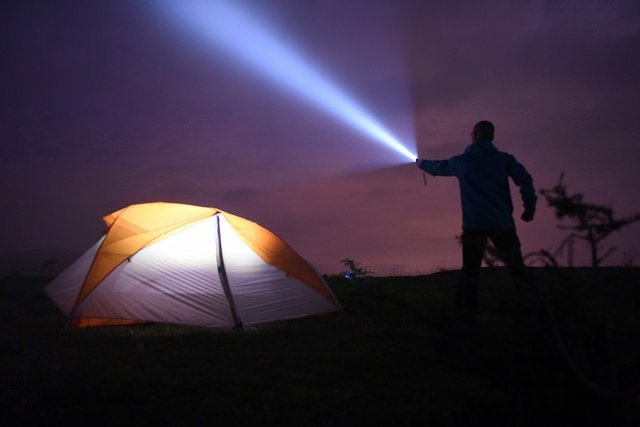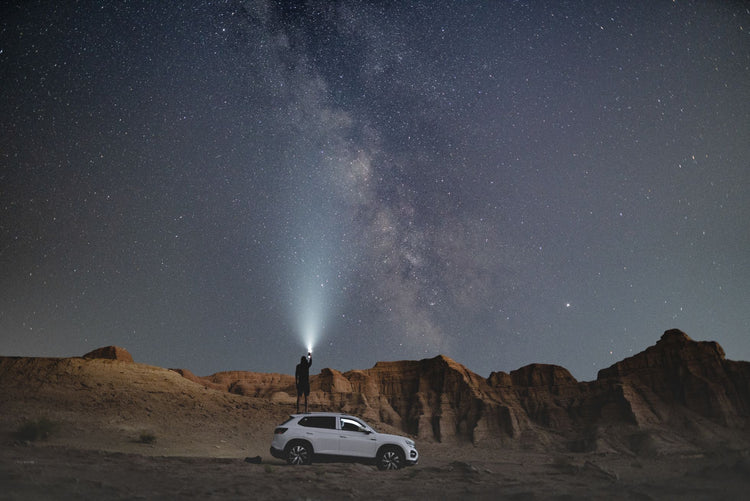What Makes a Good Outdoor Flashlight?
Getting pulled into the world of flashlights and feeling overwhelmed by all the options is common. You have pocket flashlights, everyday carry flashlights, duty flashlights, searchlights, flood lights, tactical flashlights, and more. It can be difficult to narrow down what you're looking for and what you need. If you’re an outdoor enthusiast and you just want a light that is durable and ready for the outdoors, you may be feeling a little lost as to which flashlight is best for you. So today, we want to look at what makes a good outdoor flashlight to help you narrow down your search.
Compact LED Flashlight
With any outdoor flashlight, you want something that’s compact. Now this may be different for any outdoor user, but generally we recommend a flashlight that has a length of about 5 inches or less. This size will be easy to clip onto your pocket or jacket. It's also very easy to carry in your backpack. The idea is to pack light and a compact and lightweight flashlight is a must.

Body design is another aspect to consider when purchasing an outdoor flashlight. Most outdoor users prefer the baton-style design such as the Klarus G10 rather than a more tactical design with a larger head and slimmer body like the Klaus XT11GT. As you can see in the photo above, the baton-style body of the G10 makes pocketing the flashlight easier.
You also have the option of using an LED headlamp if you prefer hands-free illumination. This is entirely a personal preference. Some users like headlamps, some like handheld flashlights, and some like to bring both.
LED Flashlight with Simple User Interface
A good outdoor flashlight will have an intuitive user interface. Of course, this can mean different things for different users. But typically, an outdoor flashlight will be pretty straightforward so that you don't really have to think too much about operating it. You have the options of choosing between side switches and tail switches. Sometimes flashlights actually offer you all three. you can choose how you'd like to operate the flashlight and what's more important to you. Tail switches are typically better for tactical use while a side switch is better for more general use.
With outdoor activities, you want a beam that allows you to see the area around you. So it's better to have a beam that's a bit more diffused and wider, either a flood beam or a combination beam. A combination beam just means that it's a beam that combines a flood and the spot. A true spotlight typically doesn't have many spills to it so while it's great for distance, it's not so good when it comes to looking at your immediate surroundings. This is why we recommend a flashlight that has a wider beam pattern. So look for flashlights that have short reflectors, textured orange peel reflectors, or mention having a wider beam angle.

Most high qualities LED flashlights come with multiple brightness levels and the same goes for any outdoor flashlight. We recommend at least three brightness levels but preferably four. While the flashlight can have an ultra-bright output, you're more likely to be using those other brightness levels because a turbo mode is not always necessary or useful. When you're navigating around the campsite, the lower outputs are usually sufficient and there's no need to use the turbo as it may only blind you and your buddies.
Speaking of brightness levels, we highly recommend a moonlight mode in any outdoor flashlight. This is a brightness level of 5 lumens or less. It's really not necessary to have a moonlight mode. The reason we recommend it is because a moonlight mode helps to save battery power and works really well to illuminate smaller areas such as inside a bag or light up a pathway in front of you without disrupting your night vision too much.
Multiple Battery Sources
A good outdoor light will be able to run on multiple battery types. So if you have a 18650 flashlight, it should be able to run on CR123 batteries or 16340 batteries. If you're using a flashlight that runs on a 14500 battery, then it would be beneficial if it also ran on an AA battery. The benefit to it running on different battery types gives you a few more options especially when it comes to backup batteries. So if you have a 18650 flashlight, it may make more sense for you to purchase CR123 batteries as backup batteries because they’re smaller and expensive. This way if your battery runs out on you during your camping trip, you have spare batteries on hand.

Sometimes flashlight users prefer LED flashlights that run on specific batteries so for example 18650 flashlights, AA-powered flashlights, etc. It's up to you what you feel most comfortable using. AA and AAA batteries are easy to come by and inexpensive. However, these flashlights typically won't have the highest outputs and the ones that do tend to run on multiple AA batteries. So that's something to keep in mind.
If you choose a flashlight that runs on an alithium-ion battery on the other hand, they can be a bit pricier and more difficult to find but really deliver on power and run times. CR123 batteries are a happy medium in between the two. They're inexpensive but also provide power and run times. We recommend using a flashlight that uses a lithium-ion battery mostly because you can save money in the end with lithium-ion batteries. Rather than AA batteries or CR123 batteries which are disposable, lithium-ion batteries can be recharged meaning that you can use the same battery for years. So consider which battery source you would prefer to use and that can help narrow down which outdoor flashlight you choose.
Durable Outdoor Flashlights

Durability is a necessity with an outdoor LED flashlight. You want a flashlight that's going to be able to take various environmental conditions whether it's raining, snowing, or just crazy hot. So make sure to check out the specs of the flashlight. we recognize the flashlights that have an impact resistance rating as well as a waterproof rating. The waterproof rating will be shown as IPX7 or IPX8. There are other ratings, but these are the most common. IPX7 means that you could drop the flashlight in 1 meter of water for 30 minutes and it would be working just fine. IPX8 means you could drop the flashlight in two meters of water for 30 minutes and it would be working fine. Both of these indicate that the flashlight is heavily waterproof. It's not great to go diving with, but if you're caught outside in a rainstorm, your flashlight will be ready to go. So definitely keep an eye out to make sure the LED flashlight you're getting is durable enough for your outdoor adventure.
There's quite a lot to consider when purchasing an outdoor flashlight, but when you get a handle on what you want in your flashlight, it becomes a lot easier to narrow the search. Consider things like what size a flashlight would be best for you, what beam pattern you want, what batteries you’d want to use, how you’d like the flashlight to operate, and how durable the outdoor flashlight is.


